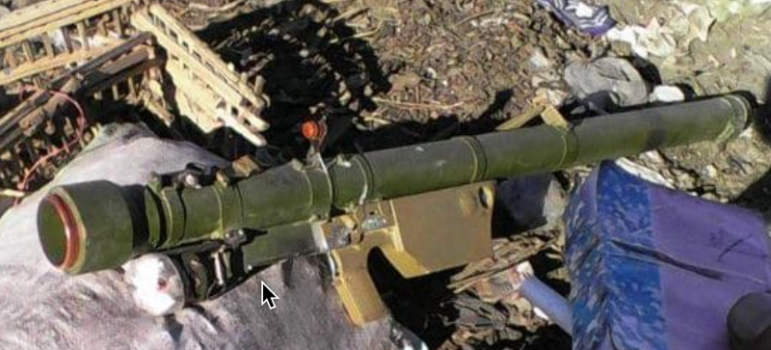
By
Egyptian traffic cops found a mobile launcher lying in a piece of pile near the airport of Cairo. The story was quickly dismissed by Egyptian media. But others believed it. In this detective & research adventure, you learn how to find the truth midst of an information war.
CAIRO / BERLIN — Ibrahim Yousry was heading to work in Cairo when he was shocked to see an anti-aircraft weapon system. A missile launcher was lying around in a heap of rubbish near the airport. He called the police.
Traffic cops came from the General Traffic Authority. They decided that this was not the best place for a mobile launcher and removed it.
Yousry posted a video of the officials discussing what to do with a thing like this.
He did that on Facebook last Saturday (Feb 25).
British newspaper The Telegraph brought the news.
— Mokhtar Awad (@Mokhtar_Awad) 20 февраля 2017 г.
Then a pro government Egyptian website (translation) called it a professional blunder. They found a link to the same video, dated February 8, 2011.
The whole story seemed bogus. The video was six years old. Back to Ibrahim Yousry. “Fishing in turbid waters is not my style,” he wrote. ’’My aim was to inform the authorities. I did get through to someone in the armed forces. I have changed the post from public to friends only.”
Later, the webdesigner deleted his video completely, moments after Egyptian newspapers tried to pinpoint the video to 2011. After posting his video and pictures on social media, the military intervened with an order for it to be removed from public view. End of story.
This is where our story starts. How do you date a mysterious missile launcher without being actually there? How do you prove who is right or wrong?
Bellingcat’s Christiaan Triebert , Henk van Ess (=me), my students from Axel Springer Akademie in Berlin and Mokhtar Awad, a Research Fellow in the Program on Extremism went on a fact hunt that took 24 hours. Hop aboard, relive our journey and enjoy the result: a fact checking manual.
CHECKING THE SOURCE
- Double checking via Google:
The source of the material was a video in Facebook from Ibrahim Yousry. He deleted his account after his video went viral. So now what? The ID number of the deleted account was 100000476775077. Here is how you ask Google to look for that number, but only on Facebook (1):

There was no cache of this page. Clicking on the link results in an error. There was no copy in Internet Archive. Arab speaking people will immediately see that there is a name at (2). We had to do it the hard way and copied the name into Google Translate:

Meet Ibrahim, our guy. We confirmed that there was a FB-account with his name in it, now completely deleted.
2. The Skype Trick
I had a strong lead for his mail-address. I typed that directly into Skype, as shown here. Add a contact first (1), type in the e-mail (2) and see if something pops up (3). The name matched.

3. Geolocating in Skype
Ibrahim comes with a self claimed location. It’s easy to miss. If you click on (3) in the last picture, nothing happens. You have to do this first:

Now the full profile is visible:

Click on the location, and you get this:
 We validated the mail-address (what) to a person (who) and a possible place (El-Kom, where) and were able to retrieve part of the deleted Facebook account (when). Not bad for a start. Chances are that our guy is real.
We validated the mail-address (what) to a person (who) and a possible place (El-Kom, where) and were able to retrieve part of the deleted Facebook account (when). Not bad for a start. Chances are that our guy is real.
4. Found something? Get rid of your sources.
He used the nick hemavb6 on Facebook and Twitter.
Here is a deceivingly nerdy trick I use in my daily routine. Did you find something interesting? Great, now get rid of the sources of the interesting facts. You want to find unknown facts. This is what I mean:

With this little trick, we established his profession. We called him but he didn’t want to talk.
4. Establishing dates of postings in Facebook
After our guy deleted the video, it popped up again here on a Facebook page from an Egyptian women. But the date was different. It was dated 2011, not 2017. A pro government newspaper used this to explain that the incident never happened.
We couldn’t find any ties between the user and Egyptian officials. What we did find that there was something odd with the date. This is what the date seemed to be:
 But now watch the clock. Even better, click on it:
But now watch the clock. Even better, click on it:

Huh? Clearly it can’t be both. Let’s hypothesise.
Is the video from 2011, but posted only just now?
Or is the video from just now, and anti-dated to 2011?
A good way to get grip on this problem is just to scroll down in the timeline:

Often the first posting of any new Facebook account (see yellow) is the (updated) profile picture and goes down to the bottom of the timeline. Here it is followed by the video (red). That’s very irregular. There seem to be no public postings from 2011 to 2014.
It is a dumb trick as anyone can backdate. Here is me uploading it in 1991. Now, why would someone do that? pic.twitter.com/RVJj602Aoh
— Mokhtar Awad (@Mokhtar_Awad) 21 февраля 2017 г.
MEANWHILE, IN THE TRENCHES OF AN INFOWAR
Mokhtar Awad didn’t buy the flat denial of government newspaper and was attacked by an “army of trolls” for that. He was accused of planting the story himself and that he was the person who misled The Telegraph, as shown here:

Awad told me, he was accused of “talking with foreign correspondents”. That’s sounds harmless but is ominous when you live in Egypt. “ I am willfully ‘collaborating’ with ‘foreigners ‘ against their country by spreading this ‘false’ story”.
An Egyptian radio- and TV presenter @daliaAO explained why the pro government media wants the story dead. She was one of many reporters that used the same argument:
“(….) I don’t share news that is unverified. This harms national security”
@Mokhtar_Awad @AhmedWagih لا خالص مش مؤامرة بس حضرتك طالما مش عايش هنا بلاش تنقل اخبار غير موثقة ده أضرار بالامن القومي
— Dalia (@daliaAO) 22 февраля 2017 г.
Translated tweet: “It’s not a conspiracy. Stop disseminating unverified news, it’s harmful to our national security.”
5. The where and the when
This morning, me and my Berlin students , Team 21, scrutinized the video once more. Earlier we did a gruelling Facebook course that only involved number crunching like this:
Brand new course wil tackle some nifty Facebook queries as shown here (=events of right wing party) Working week in #berlin at @asakademie pic.twitter.com/b8ZwboI87G
— Henk van Ess (@henkvaness) 20 февраля 2017 г.
But that knowledge wouldn’t help us to investigate the mysterious missile launcher. For this one, we looked at the video, thought, debated and looked again for any details we might have missed. Below you will hear 6 seconds of the lively discussion between the students about how to proceed this investigation. Yes, that’s German.
Is it true or not?? Students of @asakademie trying to validate @Telegraph story pic.twitter.com/gLTY4DlKw4
— Henk van Ess (@henkvaness) 22 февраля 2017 г.
An aspiring car reporter, Robin Kittelman, looked at every car he could see in the video in the hope that some of them were produced after 2011, proving that the winner of the info war was our webdesigner and not Egyptian officials. All cars were made in 2011 or earlier ;(
Sören Haberlandt came up with the idea to do some historical weather checking near the airport of Cairo for both dates in 2011 and 2017. Unfortunately, it’s always sunny in Egypt.
We were wondering why a gripstock was still attached to the tube — these are valuable and reusable. Did they leave the missile launcher in a hurry?
Others analyzed the ‘wobbliness’ of the video which suggested it was taken by an old camera but failed to come with anything conclusive.
There is a big clue in the second photo of this article. The traffic cop holds a phone. Which phone needs 3 horizontal holes in their casing (left, the traffic cop)? A likely candidate is the Samsung S3 (right, a stockphoto of a brown casing for the S3)

And what is the introduction date of the S3?

The yellow jackets of the traffic cops were puzzling. Officially they were introduced in 2012. Also the presence of an improvised battery pack suggests that the video is more recent than 2011, as the evidence available is that they were only developed (in Syria) by 2012–13.
 Clearly, enough reason to continue the validation process. And that’s where geolocating kicks in.
Clearly, enough reason to continue the validation process. And that’s where geolocating kicks in.
5. The art of knowing where you are
I love a nerdy little tool where you can stitch shaky footage of a shaky video camera into a lovely panorama photo, which could be the start of a fruitful journey through Google Earth. This is how @bellingcat often works. @Timmi_Allen dumped stills of the video into that tool and came up with this:
 Now we get more grip on where we are. There are buildings to the left, a flat, there is service road , some garbage and to the right the beginning of a highway. Also you can see, partly, a billboard.
Now we get more grip on where we are. There are buildings to the left, a flat, there is service road , some garbage and to the right the beginning of a highway. Also you can see, partly, a billboard.
All you need now is a cup of coffee, a quiet room, fast internet and Google Earth. Now it’s the turn of Christiaan Triebert to work on our little investigation. I asked Christiaan to describe the process of the next 20 minutes in that room.
“To be fair with you, this was a rather advanced video to geolocate. The first thing I did was looking for the claim where it could be, in this case near the international airport of Cairo. Then it makes sense to start in the area around the airport. Are there any Arabic words that could give away further details about the location? No. Are there visual clues? Yes: a tower, a building, and a road. They are not significant landmarks like the Eiffel Tower, but it is a start. No luck finding a similar tower in the vicinity of the airport on Panoramio. What else I can try to narrow down the location? Someone on Twitter said the video must have been taken along the Ring Road, a highway with a service road. I gave that a try.. and was lucky! Each and every building, the street, the wall, and the two ‘gates’, the market-like structure, and the tower matched exactly with satellite imagery. This is advanced geolocation, simply looking at many different streets and buildings until you think.. “Wait a second, this may be it..” — and it this case, it was indeed the correct location.”
Here we are, literally:


You can look up the exact location at Wikimapia

Some readers (of this article) have, at first, a problem with our findings:
@henkvaness @daliaAO @HASSanKHALED1 @Mokhtar_Awad sorry .. the 3 building are in parallel to the ring road but vertical in gog earth photos
— Egyptian🇪🇬💪🏽 (@drzamalkawy) 24 февраля 2017 г.
So here is a “crude sketch” to make it more clear:
@drzamalkawy @henkvaness @daliaAO @HASSanKHALED1 Certainly. This could help. Excuse the crude sketch. pic.twitter.com/5BoODq9Zeo
— Mokhtar Awad (@Mokhtar_Awad) 24 февраля 2017 г.
The next step is to get rid of the stock images in Google Earth because they are frozen in time. I want to pick my own “When” and “Where” when it comes to satellite imagery and that’s were Terraserver kicks in. Christiaan downloaded images of the following dates:

The north site of the building wasn’t finished by 13/08/2016. So the video can’t be older than that. It can’t be from 2011. It is 6 months old at most. While I was working with my students in Berlin, I asked Christiaan to compare the imagery also with 2011.

Here’s the definite proof: the building that Ibrahim Yousry taped, was non-existent in 2011. So the video can’t be taken in 2011. The debunking by Egyptian media is not based on facts. There is no proof that the incident never happened.
Aftermath
Just curious, did the Egyptian TV-reporter Dalia read this article?
@daliaAO @Mokhtar_Awad @AhmedWagih you better read this, https://t.co/myXRwZFP4P
— Henk van Ess (@henkvaness) 22 февраля 2017 г.
She did. “I am pro Egypt” she told me. Reporting the incident without the blessing of officials is impossible for her.
Shortly after this article was published, over 30 anonymous trolls contacted me via Twitter. They all made the same point: Facebook is not a serious medium for research and where is your witness? Why do you have to drag Egypt into a shameful investigation? Why don’t you concentrate on IS?
I investigated if there was a pattern to be found in this possibly controlled voice of righteous anger. Inside the trenches of this little infowar live well educated people. I was able to document 24 of the anonymous trolls and found their full names, phone numbers, mail addresses and what they are doing in normal live. Most of them are intellectuals with lovely jobs.
So how did I manage to do this? I found this information by.. hold on .. that’s another story ….for another info war.
@henkvaness @Mokhtar_Awad @daliaAO do you really call “I was told” and a Facebook post “facts”? Really? This started to be funny Henk!
— Waleed™ (@WilloEgy) 23 февраля 2017 г.
@samehabouelkhie Dear Sameh,we shouldn’t ask Mr @henkvaness To Find Isis’s location.we have to do it by our self.this our security not him
— Mohammed Sobhi (@nicesobhi2975) 25 февраля 2017 г.
Author’s note on tweet above: Some trolls ‘suggested’ me to fight IS, not Egypt. But this one doesn’t want me to do even that 🙂
By
This post was originally published on Medium and is reproduced here with the author’s permission. An Arabic translation of this post can be found here.
Dutch-born Henk van Ess teaches Internet research, social media, and multimedia/cross media. The veteran guest lecturer and trainer travels around Europe doing Internet research workshops. His projects include “Fact-Checking the Web” (CSI Internet), Handbook Datajournalism, and speaking as a social media and web research specialist.





